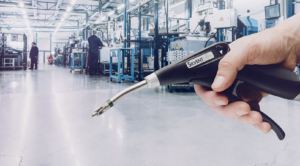Air Gun Safety – Quick Tips

Many workplace injuries occur because of the misuse of compressed air. Horseplay, however innocent it may start, can end with disastrous consequences. It may be amusing to direct a jet of air at a coworker, but it can actually produce severe internal injury. It is extremely important to understand air gun regulations when it comes to using compressed air safely in the workplace.
HAZARDS
Filings, chips, shavings, particles of metal, etc., can be thrown when compressed air is used for cleaning purposes. The pressure necessary to remove the particles from machines and surfaces is also strong enough to blow them into the eyes, ears or skin of people nearby. The greatest danger in dusting yourself down lies in accidental internal injury to the body. Compressed air can enter the body where skin is not present (i.e., ear, nose, rectum or any scratch or puncture in the skin, however small) and can cause the affected part to swell to alarming proportions and be accompanied by severe pain. If the air gets into the bloodstream, it can make its way into the small blood vessels of the brain, burst the vessels and potentially cause death. A pressure strong enough to dust or clean is strong enough to breach the skin and penetrate the body. Even pressures as low as 5-10 pounds per square inch (psi) can cause serious injury.
REGULATION
Due to the serious injuries than can be caused by compressed air, OSHA requirements pertaining to the safe use of safety air guns for cleaning purposes focus on pressure and chip guarding. The federal OSHA requirement can be found in 29 CFR Part 1910.242(b), which states: Compressed air shall not be used for cleaning purposes except where reduced to less than 30 psi and then only with effective chip guarding and personal protective equipment.
This regulation relates to cleaning objects or items only (i.e., blow drying parts that were pulled out of a plating bath). The phrase “reduce to less than 30 psi” means that the nozzle pressure or opening of a gun, pipe, cleaning lance, etc., used for cleaning purposes will remain at a pressure level below 30 psi in the event the tool is dead ended, meaning if the tip of an air gun is blocked. This can be achieved by relief ports that discharge sufficient air to reduce the air pressure at the nozzle to less than 30 psi. Employees should not use compressed air to clean themselves or their clothing while the garments are worn.
Effective chip guarding means any method or equipment that prevents a chip or particle (of any size) from being blown into the eyes or unbroken skin of the operator or other workers. Effective chip guarding may be separate from the air nozzle as in the case where screens or barriers are used. The use of protective cone air nozzles is generally acceptable for protection of the operator. However, barriers, baffles or screens may be required to protect other workers near the operator if they are exposed to flying chips or particles. Always check your local or state regulations as they may differ from the federal regulation discussed in this document.
Frequently Asked Questions
Q: Can compressed air greater than 30 psi be used for industrial purposes?
A: Yes. Most pneumatic tools, including air guns, require 80-120 psi to operate effectively and to do useful work. However, they must have a relief device or air port within the system that will drop the pressure to under 30 psi if the air system becomes dead ended.
Q: If I reduce the air pressure to less than 30 psi, can I allow my employees to clean their clothing and/or themselves with the air gun?
A: No. Under no circumstances should employees use compressed air to clean off clothing or any part of their body. Pressures as low as 5-10 psi have been known to cause serious injury. The federal OSHA regulation pertains only to the cleaning of parts or objects, not people. OSHA clarified in an interpretation letter from January 1994 that compressed air should not be used by workers for cleaning themselves or their clothing in general industry situations.
Sources
OSHA (1910.242; 1910.242(b); 1917.154)
Guard Air Corporation
The information contained in this article is intended for general information purposes only and is based on information available as of the initial date of publication. No representation is made that the information or references are complete or remain current. This article is not a substitute for review of current applicable government regulations, industry standards, or other standards specific to your business and/or activities and should not be construed as legal advice or opinion. Readers with specific questions should refer to the applicable standards or consult with an attorney.
Source: Grainger Know How – https://www.grainger.com/know-how